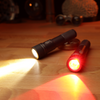
Why Divers Use Red Lights & When to Use Them
, by Nik Johnson, 4 min reading time

, by Nik Johnson, 4 min reading time
If you’ve ever seen divers hunting crayfish or lobster, you’ve probably seen someone using a red light instead of a regular torch. It might seem a bit odd at first. After all, isn’t the whole point of a dive torch to help you see as clearly as possible? So why would anyone use a light that seems dimmer or less intense?
Actually, there’s a very practical reason for it. Red light behaves differently underwater and gives divers a few important advantages, especially at night or in environments where marine life is easily disturbed.
When you go underwater, the deeper you get, the more colours start to fade. That’s because water absorbs light in order of wavelength, and red is the first to disappear within the first 5 to 10 metres. Below that, most marine creatures can’t detect redf wavelenghs, so shining a red light on them doesn’t spook them like a bright white beam would.
This makes red light ideal for underwater photography or quietly observing marine life. It’s common to see shy animals like octopus, crabs or certain fish continue behaving normally under red light, giving you a chance to watch or photograph them without interference. It also helps you maintain your own night vision. Red light is soft on the eyes and avoids the sharp glare of a white torch, especially in darker conditions so your pupils don’t contract under red light maintaining your night vision.
For practical use, I always recommend carrying a red and white light torch so you can switch back to the more powerful white light when needed. Red is great for up-close viewing, focusing your camera or searching crevices, while white light can be used when you need broader visibility.
Sailors use red lights for a very similar reason to divers. It's all about preserving night vision. When you're at sea at night, being able to see in the dark without constant eye readjustment is important for safety and awareness. Red light doesn't cause the pupils to contract the way white light does, which means you can switch between looking at instruments and scanning the horizon without blinding yourself or others onboard.
It's also less disruptive to sleep cycles. On longer trips or during night shifts, red light allows crew to move around or check gear without waking others or disturbing the calm onboard environment.
Red lights are often used on beaches that are nesting grounds for sea turtles. Bright white or blue lights can confuse hatchlings, which rely on natural light from the moon and stars reflecting off the ocean to find their way to the water. Artificial lights from torches, phones, buildings or cars can lead them in the wrong direction, often with fatal consequences.
Red light, being less visible to turtles, allows volunteers and researchers to monitor or assist during nesting season without disturbing the animals. Many coastal areas even encourage or regulate the use of red lights during nesting months.
The best light colour for diving really depends on what kind of dive you’re doing.
White light is the most versatile and is great for general use. It helps restore natural colour at depth and works well for navigation and safety.
Red light is good to have on night dives, photo and video lights for focusing and for crayfishing or spearfishing.
Blue or UV light is more specialised and is often used for detecting biofluorescence or certain substances during scientific research or for photography/videography.
High-CRI lights are popular for photography and video because they bring out more accurate colour in footage.
Personally, I carry a few lights. I use white light when I need visibility and red when I want to observe marine life. For video or photo work, I use a red light to focus, and then switch to wide beam white lights with accurate colour rendering to take the footage.
So there’s no one perfect colour, but if you dive regularly at night or love spotting critters in crevices, adding red light to your kit is well worth it.